Chenglin Li
3DGabSplat: 3D Gabor Splatting for Frequency-adaptive Radiance Field Rendering
Aug 07, 2025Abstract:Recent prominence in 3D Gaussian Splatting (3DGS) has enabled real-time rendering while maintaining high-fidelity novel view synthesis. However, 3DGS resorts to the Gaussian function that is low-pass by nature and is restricted in representing high-frequency details in 3D scenes. Moreover, it causes redundant primitives with degraded training and rendering efficiency and excessive memory overhead. To overcome these limitations, we propose 3D Gabor Splatting (3DGabSplat) that leverages a novel 3D Gabor-based primitive with multiple directional 3D frequency responses for radiance field representation supervised by multi-view images. The proposed 3D Gabor-based primitive forms a filter bank incorporating multiple 3D Gabor kernels at different frequencies to enhance flexibility and efficiency in capturing fine 3D details. Furthermore, to achieve novel view rendering, an efficient CUDA-based rasterizer is developed to project the multiple directional 3D frequency components characterized by 3D Gabor-based primitives onto the 2D image plane, and a frequency-adaptive mechanism is presented for adaptive joint optimization of primitives. 3DGabSplat is scalable to be a plug-and-play kernel for seamless integration into existing 3DGS paradigms to enhance both efficiency and quality of novel view synthesis. Extensive experiments demonstrate that 3DGabSplat outperforms 3DGS and its variants using alternative primitives, and achieves state-of-the-art rendering quality across both real-world and synthetic scenes. Remarkably, we achieve up to 1.35 dB PSNR gain over 3DGS with simultaneously reduced number of primitives and memory consumption.
METEOR: Multi-Encoder Collaborative Token Pruning for Efficient Vision Language Models
Jul 28, 2025Abstract:Vision encoders serve as the cornerstone of multimodal understanding. Single-encoder architectures like CLIP exhibit inherent constraints in generalizing across diverse multimodal tasks, while recent multi-encoder fusion methods introduce prohibitive computational overhead to achieve superior performance using complementary visual representations from multiple vision encoders. To address this, we propose a progressive pruning framework, namely Multi-Encoder collaboraTivE tOken pRuning (METEOR), that eliminates redundant visual tokens across the encoding, fusion, and decoding stages for multi-encoder MLLMs. For multi-vision encoding, we discard redundant tokens within each encoder via a rank guided collaborative token assignment strategy. Subsequently, for multi-vision fusion, we combine the visual features from different encoders while reducing cross-encoder redundancy with cooperative pruning. Finally, we propose an adaptive token pruning method in the LLM decoding stage to further discard irrelevant tokens based on the text prompts with dynamically adjusting pruning ratios for specific task demands. To our best knowledge, this is the first successful attempt that achieves an efficient multi-encoder based vision language model with multi-stage pruning strategies. Extensive experiments on 11 benchmarks demonstrate the effectiveness of our proposed approach. Compared with EAGLE, a typical multi-encoder MLLMs, METEOR reduces 76% visual tokens with only 0.3% performance drop in average. The code is available at https://github.com/YuchenLiu98/METEOR.
Noise Conditional Variational Score Distillation
Jun 11, 2025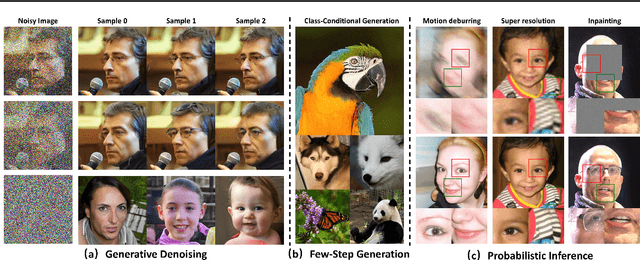
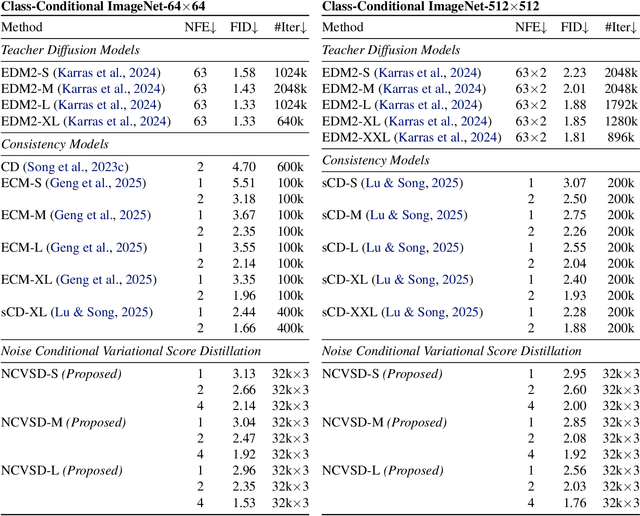

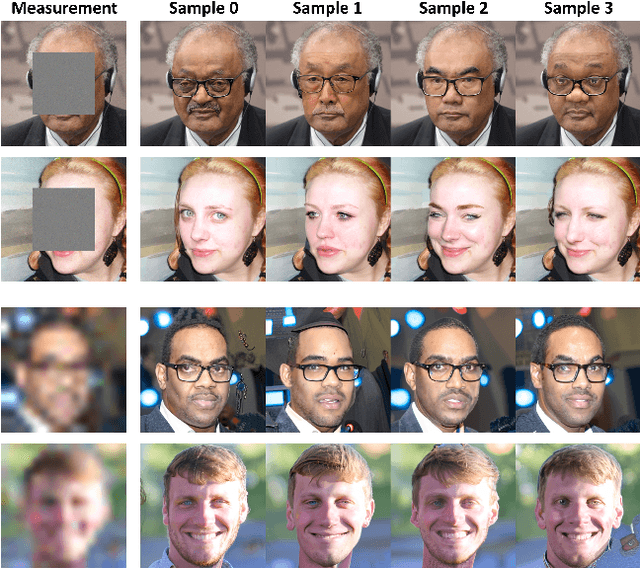
Abstract:We propose Noise Conditional Variational Score Distillation (NCVSD), a novel method for distilling pretrained diffusion models into generative denoisers. We achieve this by revealing that the unconditional score function implicitly characterizes the score function of denoising posterior distributions. By integrating this insight into the Variational Score Distillation (VSD) framework, we enable scalable learning of generative denoisers capable of approximating samples from the denoising posterior distribution across a wide range of noise levels. The proposed generative denoisers exhibit desirable properties that allow fast generation while preserve the benefit of iterative refinement: (1) fast one-step generation through sampling from pure Gaussian noise at high noise levels; (2) improved sample quality by scaling the test-time compute with multi-step sampling; and (3) zero-shot probabilistic inference for flexible and controllable sampling. We evaluate NCVSD through extensive experiments, including class-conditional image generation and inverse problem solving. By scaling the test-time compute, our method outperforms teacher diffusion models and is on par with consistency models of larger sizes. Additionally, with significantly fewer NFEs than diffusion-based methods, we achieve record-breaking LPIPS on inverse problems.
HiPART: Hierarchical Pose AutoRegressive Transformer for Occluded 3D Human Pose Estimation
Mar 30, 2025Abstract:Existing 2D-to-3D human pose estimation (HPE) methods struggle with the occlusion issue by enriching information like temporal and visual cues in the lifting stage. In this paper, we argue that these methods ignore the limitation of the sparse skeleton 2D input representation, which fundamentally restricts the 2D-to-3D lifting and worsens the occlusion issue. To address these, we propose a novel two-stage generative densification method, named Hierarchical Pose AutoRegressive Transformer (HiPART), to generate hierarchical 2D dense poses from the original sparse 2D pose. Specifically, we first develop a multi-scale skeleton tokenization module to quantize the highly dense 2D pose into hierarchical tokens and propose a Skeleton-aware Alignment to strengthen token connections. We then develop a Hierarchical AutoRegressive Modeling scheme for hierarchical 2D pose generation. With generated hierarchical poses as inputs for 2D-to-3D lifting, the proposed method shows strong robustness in occluded scenarios and achieves state-of-the-art performance on the single-frame-based 3D HPE. Moreover, it outperforms numerous multi-frame methods while reducing parameter and computational complexity and can also complement them to further enhance performance and robustness.
On Disentangled Training for Nonlinear Transform in Learned Image Compression
Jan 23, 2025Abstract:Learned image compression (LIC) has demonstrated superior rate-distortion (R-D) performance compared to traditional codecs, but is challenged by training inefficiency that could incur more than two weeks to train a state-of-the-art model from scratch. Existing LIC methods overlook the slow convergence caused by compacting energy in learning nonlinear transforms. In this paper, we first reveal that such energy compaction consists of two components, i.e., feature decorrelation and uneven energy modulation. On such basis, we propose a linear auxiliary transform (AuxT) to disentangle energy compaction in training nonlinear transforms. The proposed AuxT obtains coarse approximation to achieve efficient energy compaction such that distribution fitting with the nonlinear transforms can be simplified to fine details. We then develop wavelet-based linear shortcuts (WLSs) for AuxT that leverages wavelet-based downsampling and orthogonal linear projection for feature decorrelation and subband-aware scaling for uneven energy modulation. AuxT is lightweight and plug-and-play to be integrated into diverse LIC models to address the slow convergence issue. Experimental results demonstrate that the proposed approach can accelerate training of LIC models by 2 times and simultaneously achieves an average 1\% BD-rate reduction. To our best knowledge, this is one of the first successful attempt that can significantly improve the convergence of LIC with comparable or superior rate-distortion performance. Code will be released at \url{https://github.com/qingshi9974/AuxT}
Tilted Quantile Gradient Updates for Quantile-Constrained Reinforcement Learning
Dec 17, 2024Abstract:Safe reinforcement learning (RL) is a popular and versatile paradigm to learn reward-maximizing policies with safety guarantees. Previous works tend to express the safety constraints in an expectation form due to the ease of implementation, but this turns out to be ineffective in maintaining safety constraints with high probability. To this end, we move to the quantile-constrained RL that enables a higher level of safety without any expectation-form approximations. We directly estimate the quantile gradients through sampling and provide the theoretical proofs of convergence. Then a tilted update strategy for quantile gradients is implemented to compensate the asymmetric distributional density, with a direct benefit of return performance. Experiments demonstrate that the proposed model fully meets safety requirements (quantile constraints) while outperforming the state-of-the-art benchmarks with higher return.
Point Cloud Resampling with Learnable Heat Diffusion
Nov 21, 2024Abstract:Generative diffusion models have shown empirical successes in point cloud resampling, generating a denser and more uniform distribution of points from sparse or noisy 3D point clouds by progressively refining noise into structure. However, existing diffusion models employ manually predefined schemes, which often fail to recover the underlying point cloud structure due to the rigid and disruptive nature of the geometric degradation. To address this issue, we propose a novel learnable heat diffusion framework for point cloud resampling, which directly parameterizes the marginal distribution for the forward process by learning the adaptive heat diffusion schedules and local filtering scales of the time-varying heat kernel, and consequently, generates an adaptive conditional prior for the reverse process. Unlike previous diffusion models with a fixed prior, the adaptive conditional prior selectively preserves geometric features of the point cloud by minimizing a refined variational lower bound, guiding the points to evolve towards the underlying surface during the reverse process. Extensive experimental results demonstrate that the proposed point cloud resampling achieves state-of-the-art performance in representative reconstruction tasks including point cloud denoising and upsampling.
Point Cloud Denoising With Fine-Granularity Dynamic Graph Convolutional Networks
Nov 21, 2024Abstract:Due to limitations in acquisition equipment, noise perturbations often corrupt 3-D point clouds, hindering down-stream tasks such as surface reconstruction, rendering, and further processing. Existing 3-D point cloud denoising methods typically fail to reliably fit the underlying continuous surface, resulting in a degradation of reconstruction performance. This paper introduces fine-granularity dynamic graph convolutional networks called GD-GCN, a novel approach to denoising in 3-D point clouds. The GD-GCN employs micro-step temporal graph convolution (MST-GConv) to perform feature learning in a gradual manner. Compared with the conventional GCN, which commonly uses discrete integer-step graph convolution, this modification introduces a more adaptable and nuanced approach to feature learning within graph convolution networks. It more accurately depicts the process of fitting the point cloud with noise to the underlying surface by and the learning process for MST-GConv acts like a changing system and is managed through a type of neural network known as neural Partial Differential Equations (PDEs). This means it can adapt and improve over time. GD-GCN approximates the Riemannian metric, calculating distances between points along a low-dimensional manifold. This capability allows it to understand the local geometric structure and effectively capture diverse relationships between points from different geometric regions through geometric graph construction based on Riemannian distances. Additionally, GD-GCN incorporates robust graph spectral filters based on the Bernstein polynomial approximation, which modulate eigenvalues for complex and arbitrary spectral responses, providing theoretical guarantees for BIBO stability. Symmetric channel mixing matrices further enhance filter flexibility by enabling channel-level scaling and shifting in the spectral domain.
ColorEdit: Training-free Image-Guided Color editing with diffusion model
Nov 15, 2024

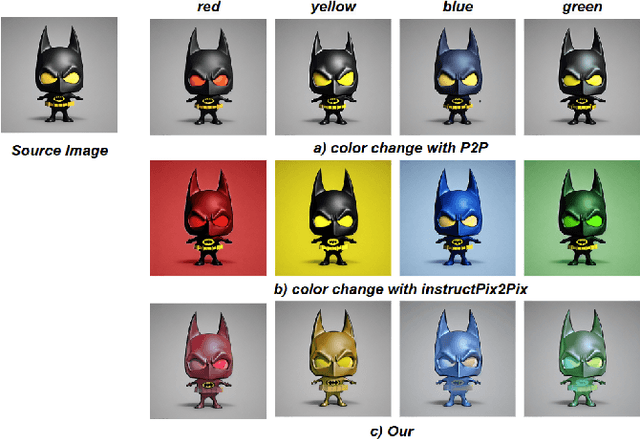

Abstract:Text-to-image (T2I) diffusion models, with their impressive generative capabilities, have been adopted for image editing tasks, demonstrating remarkable efficacy. However, due to attention leakage and collision between the cross-attention map of the object and the new color attribute from the text prompt, text-guided image editing methods may fail to change the color of an object, resulting in a misalignment between the resulting image and the text prompt. In this paper, we conduct an in-depth analysis on the process of text-guided image synthesizing and what semantic information different cross-attention blocks have learned. We observe that the visual representation of an object is determined in the up-block of the diffusion model in the early stage of the denoising process, and color adjustment can be achieved through value matrices alignment in the cross-attention layer. Based on our findings, we propose a straightforward, yet stable, and effective image-guided method to modify the color of an object without requiring any additional fine-tuning or training. Lastly, we present a benchmark dataset called COLORBENCH, the first benchmark to evaluate the performance of color change methods. Extensive experiments validate the effectiveness of our method in object-level color editing and surpass the performance of popular text-guided image editing approaches in both synthesized and real images.
VCBench: A Controllable Benchmark for Symbolic and Abstract Challenges in Video Cognition
Nov 14, 2024
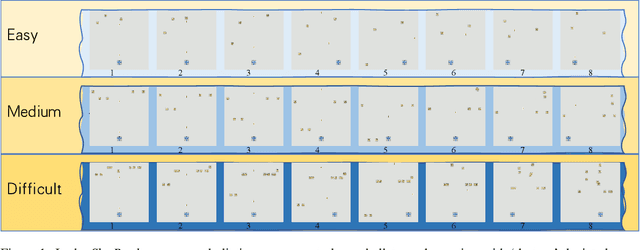
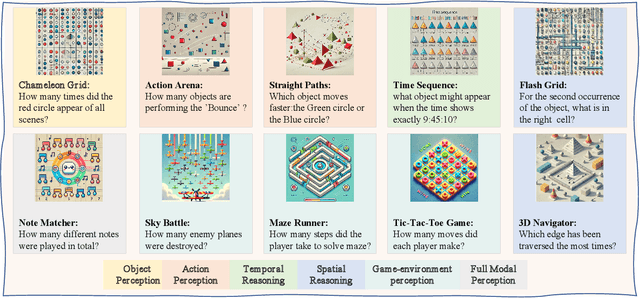
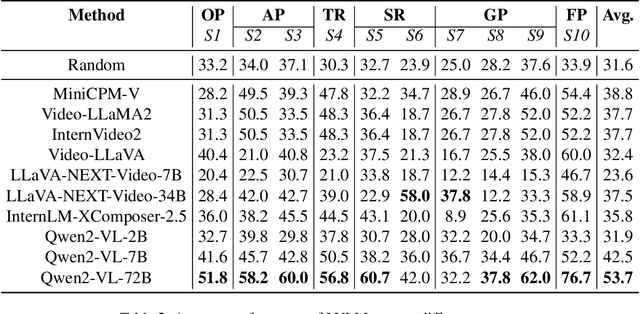
Abstract:Recent advancements in Large Video-Language Models (LVLMs) have driven the development of benchmarks designed to assess cognitive abilities in video-based tasks. However, most existing benchmarks heavily rely on web-collected videos paired with human annotations or model-generated questions, which limit control over the video content and fall short in evaluating advanced cognitive abilities involving symbolic elements and abstract concepts. To address these limitations, we introduce VCBench, a controllable benchmark to assess LVLMs' cognitive abilities, involving symbolic and abstract concepts at varying difficulty levels. By generating video data with the Python-based engine, VCBench allows for precise control over the video content, creating dynamic, task-oriented videos that feature complex scenes and abstract concepts. Each task pairs with tailored question templates that target specific cognitive challenges, providing a rigorous evaluation test. Our evaluation reveals that even state-of-the-art (SOTA) models, such as Qwen2-VL-72B, struggle with simple video cognition tasks involving abstract concepts, with performance sharply dropping by 19% as video complexity rises. These findings reveal the current limitations of LVLMs in advanced cognitive tasks and highlight the critical role of VCBench in driving research toward more robust LVLMs for complex video cognition challenges.
 Add to Chrome
Add to Chrome Add to Firefox
Add to Firefox Add to Edge
Add to Edge